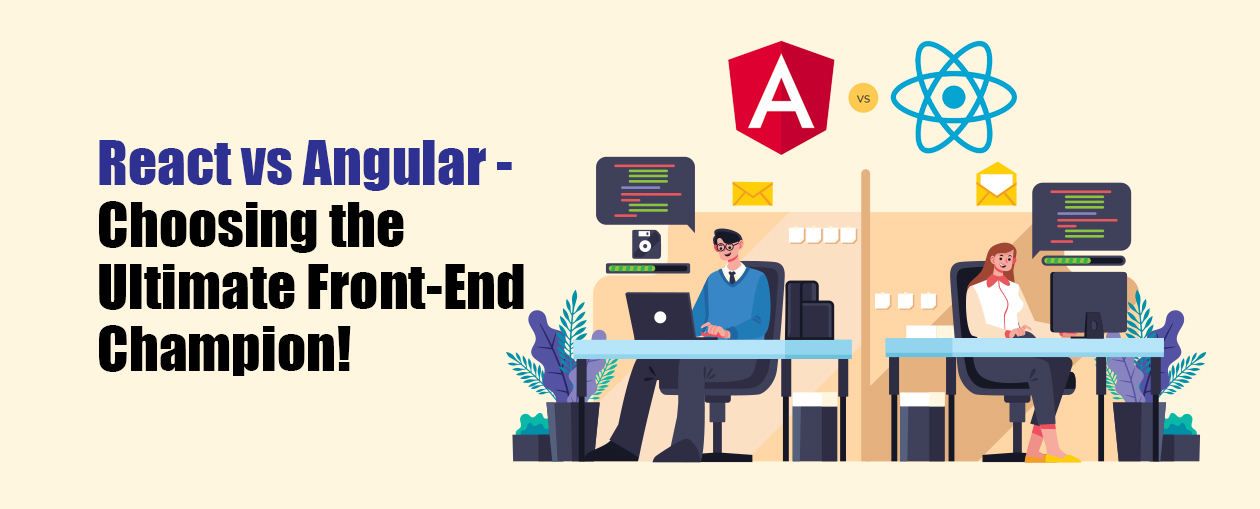The React vs Angular debate is primarily driven by differences in their design philosophies, use cases, and the preferences of developers and organizations. The choice between React and Angular depends on your specific needs and preferences. Both are popular JavaScript libraries/frameworks used for building web applications, but they have distinct characteristics.
Being a growing software development company in Canada, we have experts in both fields, and this write-up is based on their views on the battle of the Titans – React vs Angular.
Let’s have a quick overview of these two frontend giants.
React vs Angular: A Quick Overview of React
React is an open-source JavaScript library used for front-end development, particularly for building user interface (UI) components. React is often called a library because it focuses solely on the view layer of an application. You can choose other libraries or tools to complement React, which gives you more flexibility in your tech stack.
React is more flexible and less opinionated. It provides a flexible and unopinionated way to build user interfaces, allowing developers to choose their tools for routing, state management, other features, and more.
React uses a virtual DOM to optimize rendering performance, making it efficient for building dynamic user interfaces. This can result in faster updates to the UI.
React has a vast and active community and ecosystem with numerous third-party libraries and tools available.
React vs Angular: A Quick Overview of Angular
Angular is a complete front-end framework that provides a comprehensive set of tools and opinions for building web applications. It includes features like routing, state management, and dependency injection out of the box. This opinionated approach can be seen as either helpful or restrictive, depending on the project’s requirements.
Angular is built with TypeScript, which is a statically typed superset of JavaScript. TypeScript can help catch errors during development and improve code maintainability.
Angular offers two-way data binding, which can simplify UI development in some cases.
The dependency injection system makes Angular easier to manage and test components.
Angular represents a complete overhaul of AngularJS, developed by the same team of Google engineers. AngularJS is no longer actively maintained. In this blog’s context, I’m referring to Angular 2, which serves as a collective term encompassing all subsequent versions of Angular that followed AngularJS.
React vs Angular: A Quick Comparison
In this section, we are taking the ‘React vs Angular comparison’ to a higher level by setting both of them against certain parameters.
- Learning Curve
React is generally considered to have a lower initial learning curve because it’s a JavaScript library with a more straightforward API. Developers can start using React with a basic understanding of JavaScript. This library is optimized for SEO and prioritizes rendering speed. As a result, companies incorporating React into their projects can anticipate reduced loading times and improved search engine rankings.
Angular, with its use of TypeScript, decorators, and a more extensive set of concepts, may have a steeper learning curve, especially for developers new to TypeScript or complex front-end frameworks.
- Flexibility vs. Convention
React provides flexibility, allowing developers to choose their libraries and tools for various aspects of development. This flexibility can be empowering but may require more decision-making.
Angular enforces a set of conventions and best practices, which can be beneficial for large teams or projects where consistency and maintainability are crucial. However, it can feel restrictive to developers who prefer more freedom.
- Community and Ecosystem
React has a massive and active community, leading to a rich ecosystem of third-party libraries, components, and resources. This broad adoption and ecosystem make it a popular choice for many projects.
Angular also has a significant community, but its ecosystem may not be as extensive as React’s. However, Angular’s comprehensive nature means that many features are built in. The key benefit of adopting Angular is its strong association with Google, which provides robust, long-term support for the framework. This ongoing commitment from Google has led to continuous growth within the Angular ecosystem.
This is evident through the widespread use of the Angular framework in various Google applications. As trust in the framework continues to solidify, it opens up valuable learning opportunities for aspiring developers, who can gain insights from experienced Angular professionals.
- Project Requirements
The choice between React and Angular often comes down to the specific needs of a project. React’s flexibility makes it a good fit for various project sizes and types, while Angular’s structure can be advantageous for larger, enterprise-level applications.
- Developer Preferences
Personal developer preferences play a significant role in the debate. Some developers prefer React’s simplicity and the ability to choose their stack, while others appreciate Angular’s structure and built-in features.
Major Adopters of Angular and React
Currently, Angular is adopted by over 500 prominent global companies, firmly establishing its position among the most popular technologies. Thanks to its versatility, Angular caters to a wide range of industries, spanning from the software sector to the gaming industry, making it a dependable choice for all. Examples of companies that use Angular are Google, Microsoft, IBM, Deutsche Bank, PayPal, Forbes, Upwork, etc.
Based on the 2018 State of Developer Ecosystem Survey, React enjoys a widespread adoption rate, with 60% of developers incorporating it into their projects worldwide. Facebook, known for having one of the largest active user bases globally, further underscores React’s popularity as it leveraged the framework for its mobile app. Prominent companies that utilize React include Facebook, Instagram, WhatsApp, Netflix, Atlassian, Dropbox, the New York Times, etc.
Wrapping Up
In essence, the React vs Angular debate exists because both technologies have their strengths and weaknesses, and the choice between them depends on factors like project complexity, team expertise, and development philosophy. Developers and organizations need to evaluate these factors carefully to make an informed decision.
In conclusion, there is no one-size-fits-all answer. React and Angular are both powerful tools, and the best choice depends on your project’s requirements and the expertise of your development team. It’s essential to evaluate your specific needs and conduct a thorough analysis before making a decision. If you are in need of highly qualified React and Angular developers to join your team, hire developers for your team instantly. Reach out to us to know more.









